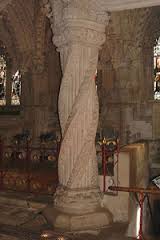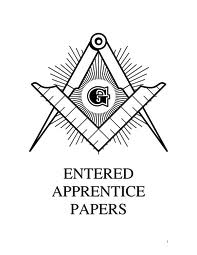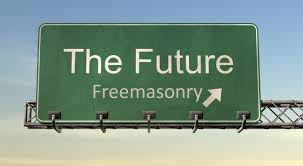This article provides the legend and lessons behind a famous work of craftsmanship in Masonic lore. John Cooper, a Freemason for nearly 50 years and noted Masonic writer and scholar was installed in October 2013 as Grand Master of the Grand Lodge of California after previous service for the Grand Lodge as Grand Secretary. He has a Ph.D. in Education from Claremond Graduate School in Los Angeles, and served for 25 years as a public high school and community college teacher and school administrator. He has bachelors and master’s degrees in political science from the University of California, Los Angeles. Article reprinted from the California Freemason, August-September 2011

Apprentice Pillar
In Rosslyn Chapel, in Scotland, stands a memorial to the remarkable skill of the stonemason’s art. Called the Apprentice Pillar, it might also be called the Pillar of Beauty, for it is an exquisite example of freestone carving by and operative mason. The legend, which may not be as old as the pillar itself, tells of the tragic end of the craftsman who carved it, and the jealousy that caused his murder.
Crime of Passion
It begins with a Master Mason who assigns an Entered Apprentice the task of carving the third, and most beautiful, of the central pillars in the chapel. He does not give the Entered Apprentice any instruction in how to carve the pillar, perhaps because he wants the Entered Apprentice to fail at the task.
The Master Mason then sets off for a foreign land, ostensibly to study a famous pillar and then bring the design back to the chapel, where he will complete the pillar that the failed Entered Apprentice could not carve. However, upon his return, he discovers that the Entered Apprentice has completed the pillar, and that he has done so with a skill that the Master Mason could never hope to achieve. In his anger, the Master Mason strikes the Entered Apprentice on the forehead with a setting maul, felling him dead at his feet.
As punishment for his crime, the other stonemasons carve a stone head representing the Master Mason along the inner wall of the chapel, with its gaze forever fixed on the Apprentice Pillar. And across from this, they7 carve another head – one representing the slain Entered Apprentice, with a great wound on his forehead, gazing forever at the stone head of his murderer. The crime and its consequences were carved in stone for all time.
Regardless of whether this legend has any basis in fact, the beautiful Apprentice Pillar is still in Rosslyn Chapel, and the stone heads are still looking on after all these centuries. There is a Masonic allusion in this tale, but there is also a deeper Masonic significance in what the story tells us.
Lessons carved in Stone
The legend is about the failure of the Master Mason to perform his prime duty of instructing his Entered Apprentice, and, instead, plotting to discredit him and claim the glory for himself. It backfires, and instead of our remembering the great skill of the Master Mason, we remember only his betrayal. The beauty created by the Entered Apprentice is his lasting memorial.
The story teaches three Masonic lessons that we should not forget. First, it is the duty of every Mason to empower another Mason to succeed. Every Entered Apprentice is told that his “future moral and Masonic edifice” will be built well and truly if he stays close to the “master builder” in his lodge – symbolically represented by the Master of the Lodge. That, in turn, requires the Master to teach Freemasonry to those in his charge, and particularly to a new Mason.
Second, we are taught to circumscribe our passions, and keep them within due bounds. Focused energy is a blessing; unfocused anger and rage is destructive of all societies, and especially of ours. Jealousy has no place in Freemasonry, for – as we are taught – a Mason only succeeds in an environment of those who can work together and agree.
Finally, there is another lesson that comes from this old legend of Rosslyn Chapel and its Entered Apprentice Pillar: the lesson of doing what we are expected to do in the best way that we can, regardless of the consequences. It is possible that the Entered Apprentice Knew that he would be in trouble if he completed carving the pillar that the Master Mason had expected to complete himself. But he did so because he wanted to create a thing of beauty. That urge overrode any other possibility.
Give the world the best you’ve got
I am reminded of a beautiful poem by Kent M. Keith, which supposedly hung on the wall of Mother Teresa’s home in Calcutta, India:
People are often unreasonable, illogical, and self centered; Forgive them anyway.
If you are kind, people may accuse you of selfish, ulterior motives; Be kind anyway.
If you are successful, you will win some false friends and some true enemies; Succeed anyway.
If you are honest and frank, people may cheat you; Be honest and frank anyway.
What you spend years building, someone could destroy overnight;
Build it anyway.
If you find serenity and happiness, they may be jealous; Be happy anyway.
The good you do today, people will often forget tomorrow; Do good anyway.
Give the world the best you have, and it may never be enough; Give the world the best you’ve got anyway.
You see, in the final analysis, it is between you and your God; It was never between you and them anyway.
As the Entered Apprentice of old carved his pillar because it was the best that he could contribute to his beautiful chapel, so we as Masons contribute the best that we can every day to the betterment of the world around us. Regardless of the consequences, he carved his pillar anyway, and regardless of the consequences, we, too, live as Masons should anyway.






You must log in to post a comment.